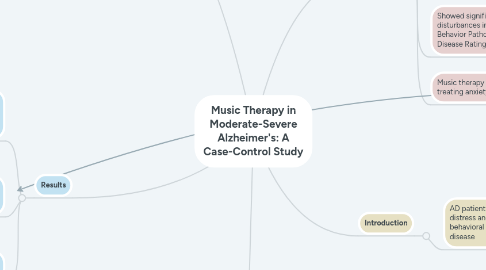
1. Methods
1.1. Initially 47 patients (1 patient declined to sign consent, making 46 patients)
1.1.1. Age ranged 71-87 years
1.1.2. Diagnosed with AD according to ICD-10
1.1.3. Moderate to severe dementia according to stages 5-7 on the Global Deterioration Scale
1.1.4. Patients with other types of dementia were excluded
1.1.5. Randomly assigned to music therapy group or control group, 23 patients in each group
1.1.6. 8 patients were either moved from the psychogeriatric ward to a nursing home, deteriorated or died, making 38 patients for the study (20 in music therapy, 18 in control)
1.1.6.1. Each patient was rated with BEHAVE-AD by two nurses, each were trained in the scale and blind to the therapy in question
1.1.6.1.1. Therapy group received 18 sessions of music therapy lasting 30 minutes, 3 times a week for 6 weeks
1.1.6.1.2. Control group had no change in daily care
1.1.7. Study was approved by bioethics committee and CDC in Iceland
2. Results
2.1. Most reported symptoms using BEHAVE-AD were activity disturbances and paranoid/delusional ideation (also infrequent hallucinations or diurnal rhythm disturbances)
2.2. Significant decrease in symptoms rated as activity disturbances after 6 weeks with music therapy (p=0.02)
2.2.1. Effect decreased back to baseline after 4 weeks of no music therapy
2.2.2. Non-significant decrease in total points of the BEHAVE-AD after 6 weeks of therapy but significant reduction in 3/7 categories (activity disturbances, aggressiveness and anxiety, p < 0.01)
2.3. Control group did not have decrease in symptoms (p > 0.5)
3. Discussion
3.1. Can argue that symptoms that result from a desire for activity and loss of ability to create meaningful activity can be treated with music therapy
3.1.1. Anxiety is often the result of a patient having difficulty in identifying their surroundings
3.1.1.1. Study proved that in 6 weeks, sub scales of the BEHAVE-AD measuring activity disturbances, aggressiveness and anxiety showed significant change in the music therapy group
3.1.1.1.1. Strength of the study is that it was a single-blind, placebo-controlled with comparable groups at baseline
3.1.1.1.2. Limitations of the study were the small sample size and the 20% dropout rate which was expected due to the patient group
3.1.1.1.3. No comparison between different types of music or different types of music therapy (passive listening or singing)
3.1.1.1.4. Only a few patients had substantial symptoms as rated by the BEHAVE-AD model and the rest had moderate-minor symptoms
3.1.1.1.5. Advantage of music therapy is the lack of side effects and increased interest on behalf of the staff in caring for/treating AD patients
3.2. Hard to argue that symptoms due to organic changes (hallucinations/misidentification) can benefit from this kind of therapy
3.3. Music therapy is already used in a variety of ways including treated depression older individuals with depression who do not have dementia and who do
3.4. Another study showed that music therapy had improvement on cognition, which was evaluated by the Mini-Mental Status Examination
4. Abstract
4.1. Music therapy can be a potential non-pharmacologic therapy for patients with symptoms of dementia
4.2. Case-control study conducted by qualified music therapists
4.3. Two nursing homes and two psychogeriatric wards
4.4. 38 patients with moderate to severe Alzheimer's randomly assigned to the therapy group or the control group
4.5. Showed significant reduction in activity disturbances in a 6 week study using the Behavior Pathology in Alzheimer's Disease Rating Scale (BEHAVE-AD)
4.5.1. Reduction in activity disturbance, agitation and anxiety
4.5.2. Effects mostly disappear in 4 weeks of no treatment
4.6. Music therapy is safe and effective in treating anxiety and agitation
5. Introduction
5.1. AD patients show signs of psychological distress and have a range of aberrant behavioral patterns in the later stage of disease
5.1.1. These are called behavioral and psychological symptoms of dementia (BPSD)
5.1.1.1. BPSD are episodic rather than progressive
5.1.1.2. Often a cause of referrals to nursing home or short periods of hospitalization
5.1.1.3. Argued that even modest benefits in BPSD can improve quality of life and can make the difference between living at home or hospitalization
5.1.1.4. Treatment is often pharmacological (sedatives, neuroleptics or antidepressants)
5.1.1.4.1. Can cause unwanted side effects and raises the question about inappropriate use of psychoactive drugs in nursing homes
5.1.1.4.2. Lack of reliable research on non-pharmalogical therapy due to limited number of subjects or limited case reports

